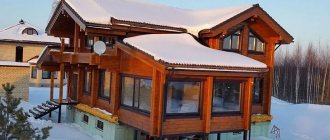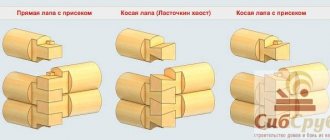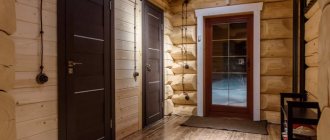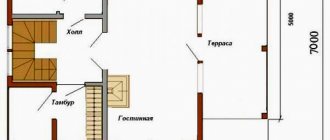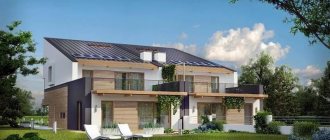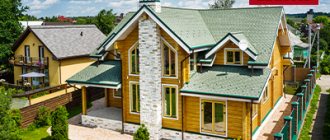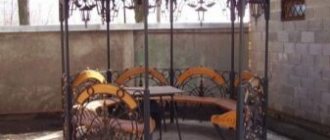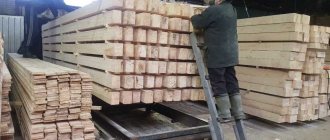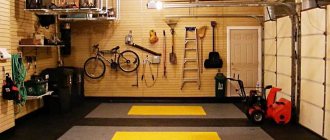In order not to fall for their marketing ploy, you need to understand what the term “Canadian frame house” includes.
Many developers will be very surprised to learn that in Canada they actually build frame residential buildings not from SIP panels, but with mineral wool insulation.
Local authorities in Canada are interested in having as many such energy-efficient houses on their territory as possible, helping developers in every possible way, for example, connecting these facilities to central utility networks for free.
Canadian houses: a little history
The first frame buildings were known in Europe during the early Middle Ages. In those days, the structure was based on a system of posts and beams with braces located diagonally. The space between the parts of this frame structure was filled with stone, bricks or clay.
Colonists who came to Canada and the United States from Europe used this technology, which allowed them to create houses at any time of the year in a short time. To protect against the harsh weather conditions of Canada, the walls of the houses were covered with boards on the outside and inside, and the voids were filled with any available material. Most often a mixture of clay, straw, sand and stone was used.
Houses in old European cities are “distant ancestors” of modern frame technology Source nkkconsult.ru
Thus, the basis for creating houses using Canadian technology even in those days was the prototype of insulated panels, with the help of which it was possible to build a high-quality warm house in the shortest possible time. Modern technology of “Canadian houses”, adapted for harsh climatic conditions, has a number of advantages and disadvantages.
Canadian features
Canadian construction legislation is very strictly regulated. The technologies, materials used and their manufacturers are spelled out once and for all. It is possible to prove the suitability of other building materials, but this is a long and unprofitable job. References to the experience of other countries will not work.
Canadian building codes are not universal. Different provinces have different regulations.
In Canada, the construction of wooden houses with 6 floors is allowed.
Not a Canadian project, a US one. Wooden frame 36 meters high. "475 West 18th", New York.
The methodology for calculating the energy efficiency of houses is different from the Russian one. The essential thing is that there are heat conservation criteria that cannot be violated. In Ontario, 100 mm of polystyrene foam on top of 150 mm of mineral wool is the norm.
Canadian SNiPs do not exist in the public domain. This is the intellectual property of the developers. You must pay to access any document.
Advantages of modern Canadian houses
A frame house using this technology is built from panels covered with OSB (a material made from wood chips impregnated with polymer resins) and insulated with polystyrene foam. The dimensions of the panels are selected individually, taking into account the size of the finished building. Insulated panels are ready-made wall elements that are fixed on a pre-built foundation. After this, the installation of floors, roofs, as well as doors and windows occurs.
- The main advantage of the technology is the speed and ease of building a house. Installation work does not require the involvement of specialized equipment and a large team of builders; on average, a house is erected within 2-3 months.
- A frame structure using Canadian technology will cost about half the price of a full-fledged brick house, while the functional characteristics of both buildings are similar.
Facing brick in the design of a frame house Source karkasblog.ru
- Lightweight panels do not require the construction of a powerful foundation, so they can be built on areas with any terrain.
- Expanded polystyrene, filling the space between the panels, has high insulating properties. Therefore, the finished building does not require additional sound insulation and insulation.
Unlike dwellings made from beams or logs, Canadian wooden houses allow installation of utilities inside the panels themselves. Thus, finished living spaces look more aesthetically pleasing, and less time and effort is spent on installation.
- Wooden panels at the base of the frame create a pleasant atmosphere in the house.
- The lightweight wall material allows you to choose various methods of exterior finishing of the finished building: decorative brick, plaster, boards - all this is available to owners of frame houses built using Canadian technology.
- Thanks to the production of custom-made panels, the finished structure can have almost any architectural form.
Options for layouts and projects
All such households, starting from the middle of the last century, have been built with complex architecture :
- multi-storey;
- with warm attics and a warm garage;
- verandas;
- terraces and balconies.
Premises on the 1st floor, as a rule, have high ceilings up to 3 m, large square, rectangular or arched windows. The first floor is a guest floor, there is a spacious hall, living room and dining room. The second floor is used for living rooms, there is also a nursery and an office.
Furnaces are usually located in basements, and air heating is provided throughout the house through a duct system. A general air conditioning and ventilation system is also installed. There is a separate laundry area in the basement or utility room on the first floor.
Exterior finishes in most parts of Canada are imitation brick, a material bonded to the outside of the wood frame. Roofs are often covered with asphalt or cedar shingles; recently, metal tiles have become more popular.
Disadvantages of building a house using Canadian technology
Despite many obvious advantages, houses using Canadian technology have a number of features and limitations, due to which they are not suitable for all owners of suburban areas. The main feature of the technology is the limitations on the dimensions of the finished building. The height of each floor should not exceed 3 meters, there can be a maximum of 3.
The compactness of Canadian houses does not affect their functionality and pleasant appearance Source avantage-dom.ru
The environmental friendliness of the finished building may raise questions due to the abundance of polymer resins impregnating the product. However, this is a question of the integrity of the manufacturers of such structures - if the panels are made in compliance with the technology, then they comply with all environmental safety standards.
The characteristics of a finished residential building, in addition to the quality of the material, are also determined by the professionalism of the team of workers. If the contractor’s integrity combines with high-quality components and finishing according to all the rules, then a Canadian house is a comfortable and durable home.
Foundation
A common option for building frame structures is a strip foundation, which is a concrete structure immersed in the ground by about 50 cm, the height above the ground is 20-30 cm. With correct calculations, a strip foundation allows you to erect a residential building on various types of soil, including swampy and mobile ones. The main disadvantage of such a foundation is the inability to carry out a global redevelopment of the house over time.
Ready-made strip-column foundation “in cross-section” Source emupauto.ru
Screw foundations can be sunk to a considerable depth, which makes it possible to use them to create a foundation for a house on difficult soils. The main disadvantage is that noticeable shrinkage of the structure is likely, especially if there are errors in calculations or violation of technology. As a result, finishing work will have to wait for some time after completion of construction work. In addition, there is no need to think about either the basement or the ground floor in such a house.
Screw foundation made of metal piles Source 72.ru
The most reliable option is a slab foundation, which is a flat reinforced concrete “pillow” on which the structure is erected. Due to its high cost, it is usually not used when building prefabricated houses using Canadian technology, but on sandstone or when there is an abundance of groundwater, this may be the only possible option.
Schematic diagram of creating a slab foundation Source profundamenti.ru
Most often, the cost of the foundation is calculated separately from other work on the construction of a frame house. Experienced specialists will help the customer choose the optimal type of foundation depending on the characteristics of the building and the surface on which it will be built.
What does the concept mean?
By this term, experts understand a prefabricated structure with a completion period of 2 to 5 months .
The basis of the house is a wooden frame formed from solid wall structures. Houses can be produced both for permanent residence and for seasonal residence in the form of summer country houses.
The difference between them is in the thickness of the insulation; in the first case, a reinforced layer is installed in the wall - from 200 mm, in the second - no higher than 150 mm.
In addition, permanent residential buildings for permanent residence are characterized by a significantly high level of life support . Such a household must have reliable autonomous or centralized sources: electricity, water supply, sewerage and heating.
The issue of mandatory gasification in the regulatory plan for houses with permanent and seasonal residence is not fixed; everything will depend on the availability of main gas pipelines in the development area.
to erect such buildings in any place, on any soil, without fear of subsidence of load-bearing structures. Such buildings do not need a reinforced foundation, since the weight of wall structures and roofs is small compared to stone structures.
Frame houses in Canada are built only by certified teams; the work of each stage of construction is checked by state supervision; without its visa, the house cannot be put into operation. This ensures high quality houses and long standard service life - more than 100 years.
There are two options for constructing Canadian buildings using frame technology - on site, on site and in a factory using modern CNC machining equipment. Canadian developers, according to statistics, build frame houses on the construction site in 89% of cases, and only in 11% of cases are they prefabricated. This is due to the significant difference in cost of these construction options.
Canadian prices for the construction of frame housing construction: assembly of factory-made elements on the construction site - $1,800 per 1 m2; modular frame-panel buildings, houses 18x4.9 m - $2,500 per 1 m2; ready-made factory house with utilities - $3,500 or more per 1 m2.
Book and film by Larry Hohn "The Very Efficient Carpenter"
Reliable and easy-to-install SIP panels, which are easy to install without additional construction equipment, allow you to create a home with your own hands.
The book and film by carpenter Larry Hohn, “The Very Efficient Carpenter,” describes in detail the process of building a frame house using Canadian technology. Each chapter of the book and episode of the film is devoted to the components of the house: floors, walls, roof, as well as self-construction of the stairs. At the beginning of the video, the process of calculating the required amount of building materials is described, the necessary tools are mentioned, and the progress of the work itself is shown in detail.
Eventually
Classic Canadian or American frames are rarely found in domestic designs - why choose one when you can mix. The platform simplifies further work and assembly of walls, but instead of double strapping, a crossbar can be used, and instead of a windproof film, MDVP is increasingly being installed. Also, UVF or USHP becomes an excellent basis for a two-story Canadian frame and the absence of a platform does not bother anyone. But in any embodiment, a detailed design, high-quality materials, sufficient insulation and a wall cake with all membranes are required.
What to assemble the frame from is discussed in one of the thematic articles. For more details on how to avoid RSC, see the material on how not to build frame houses. In the video there is a review of a Finnish frame house.
Subscribe to our Telegram channelExclusive posts every week
Video description
Larry Hohn's film:
The Work of a Master shows that the construction of a durable building requires not only experience and skill, but also the selection of materials with the necessary technical characteristics. Unfortunately, when creating a home, “there are no small details.” For example, an incorrectly created foundation or a violation of roof insulation technology leads to premature destruction of the house.
The process of constructing a frame house Source 1asku.ru
Stages of construction of a Canadian townhouse
We produce SIP blocks with the required parameters according to the building design. This allows you to optimize material costs. The construction of a cottage consists of several stages:
- Supply of house components to a personal plot.
- Installation of a strip, column or pile type foundation.
- Assembly of external walls, interior partitions and ceilings.
- Installation of double-glazed windows, door sets and finishing of premises.
Consequences of technological errors during the construction of a building
The main mistake when building a house is inappropriate savings. SIP panels are based on wood, so it is strongly recommended to pay attention to their quality. Damp, improperly dried or rotten wood means future gaps in the walls, drafts and rapid destruction of the house.
All joints in the finished structure must be adjacent to each other as closely as possible; all gaps must be treated with sealant and construction foam. This will avoid unnecessary “cold bridges” (places of penetration of rain and wind), which contribute to the destruction of the house.
A finished house made of SIP panels, treated with sealant: the seams are tightly adjacent to each other Source tutknow.ru
Tightly fitting panels require the installation of additional ventilation, as well as the use of artificial gaps. Before starting work, you should ask the builders exactly how the house will be ventilated.
The quality of the factory-made panels themselves should be checked before installing the building. As a rule, high-quality SIP panels have smooth edges, regular shape and uniform color. It is strongly recommended not to purchase cheap Chinese-made stoves that are not adapted to harsh weather conditions.
Features of construction technology
Despite the fact that this group of houses belongs to the frame type, they have their own characteristics :
When constructing a frame, a platform is first assembled to cover the 1st floor, which will become the base of the frame skeleton.- The walls are assembled on a platform in a horizontal position, they are then raised and installed strictly vertically on the lower frame along the foundation.
The maximum inter-column distance along the axes is 600 mm, which further allows for reliable and tight installation of insulation mats. - Set of multi-layer wall.
- Making the top lining of the walls with boards.
- Making a multi-layer floor, the boards are laid on the top frame on the edge.
- For long rooms it is possible to install an intermediate support beam.
- Arrangement of warm corners.
- Construction of a technological opening for windows and doors; a lintel made of double or triple boards is installed in the load-bearing walls.
- To stabilize wall structures, 25x100mm jibs are installed at an angle of 45 degrees with respect to the vertical support posts.
Popular Canadian house designs
The most common house designs using Canadian technology are one-story, one-story with an attic, standard two-story, and also houses with a garage.
A traditional one-story house with a large porch and a gable roof is the best option for a small family. Finishing with plaster and wood panels, as well as laconic forms create a complete look of the building. The absence of large windows and a glazed veranda will save on heating the building.
One-story house with a porch and large windows Source blog-potolok.ru
The original architecture of a one-story building with an attic is created thanks to the irregular shape of the windows. The gable roof used in the architectural design prevents moisture accumulation and protects the roof from leaks. A glazed porch is a miniature analogue of a summer veranda.
The porch of a two-story house is adjacent to the end wall Source seattlehelpers.org
The combination of a small terrace, stone finishing and plaster gives the two-story house solidity and good quality. At the same time, the architectural solution is very compact and budget-friendly: the gable roof is easy to install, heating costs are kept to a minimum thanks to the open porch and terrace on the second floor.
A solid two-story house with large windows and a terrace Source ekzo.by
Cladding with natural stone and brick is a sure way to add exclusivity and reliability to an affordable and laconic home. Small attic windows, originally decorated chimneys and a modest porch give the building a complete look. An organically built-in garage with small windows can be used as an outbuilding.
Two-story house with an attic and a built-in garage Source belarusinfo.by
Finnish frame building school
Finnish frame houses, with very rare exceptions, are built on an insulated foundation, which is associated not only with the harsh climate, but also with the assembly technology. If the “Canadian” begins to be assembled from the platform, and only after it they begin to build the walls, then the Scandinavians immediately install the walls and roof on a slab or tape with backfill. Finnish architecture tends towards minimalism and laconicism - a house can be large, but on one floor.
In the original version, Finnish frame houses are factory-made, the only difference is in scale.
- Ready-made wall structures - not only with windows and a door or doors, but also with facade cladding; all that remains is to assemble them at the construction site. Finnish windows are always energy efficient, two-chamber with a combined profile: internal wood, external aluminum. The doors are also only frost-resistant, insulated, and even in the absence of a cold vestibule, freezing and condensation are excluded.
- Small-format panels - sizes vary, but on average they are up to 2.6 meters high and up to two meters wide, each covered on both sides with racks that are joined through a seal. Windows and doors are also already installed, and the final façade covering is installed on site after the frame is assembled. Both in the finished walls and in the panels, the load-bearing racks are made with a thermal break to minimize heat loss. It is unrealistic to repeat this under construction site conditions, and the problem of cold bridges is completely solved by cross-insulation.
It is almost impossible to deliver a house kit consisting of completely finished walls from Finland due to its large dimensions. But it’s quite possible to order wall panels assembled like a kit, if your budget allows, from almost any local company.
If we consider the Finnish frame directly, it is also assembled exclusively from dry planed boards with a cross-section of 190×45 mm. Compared to the Canadian one, the Finnish one is somewhat simplified - instead of double strapping and reinforcing the openings with headers, a crossbar is cut into the racks under the trim.
But if, in order to reduce the cost of construction when assembling a Canadian frame, although it is creaking, it is permissible to use wood with natural moisture content, this will not work with the Finnish one precisely because of the crossbar. When dry, the racks made of damp wood will shrink, and the crossbar embedded in them will stop working, since instead of a stop it will hang on the nails. Whatever the price of a dry planed board, you will have to spend money.
The rigidity of the frame is achieved through the crossbar and the use of MDVP boards (soft wood-fiber boards) as wind protection. Scandinavians do not use OSB outside; instead, they cover the frame with moisture-resistant façade plasterboard. Since the houses are one-story, and together MDVP, plasterboard and finishing sheathing will give the frame sufficient rigidity, the jibs are not a mandatory element, but if desired, they can be embedded for your own peace of mind.
The rafter system in Finnish frame houses is assembled from trusses, factory-fixed on gear plates. The advantage of this design is the possibility of eliminating internal load-bearing partitions and combining space, which is quite popular in country houses. The rest of the roof is standard and necessarily includes a protective membrane and installation of sheathing to form a ventilation gap.
Mineral wool is also used as insulation in the walls, and cellulose insulation – ecowool – is blown or poured into the attic floor. It is poured either directly onto the vapor barrier film, or a layer of slab insulation is pre-laid. The thickness of the insulation in the walls is 200 mm or more, the thickness of the insulation in the attic floor is 300-400 mm.
An important note.
TalovaloFORUMHOUSE Member
It might also be useful to someone. The Finns also have “dacha” and “permanent residence” class houses. A dacha usually differs in its insulation layer, layout, glazing and the windows themselves. And what Russian people often consider to be a “real Finnish house”, made of timber or logs, are usually dachas intended for occasional visits or for rent to Russian tourists.
There are no frames without vapor barrier, and Finnish is no exception in this regard, but both thick film and diffusion membranes are used.
Porcupine Member of FORUMHOUSE, specializes in the construction of Finnish houses
It seems to me that recently, “smart” VCL membranes with limited vapor permeability have become more often used for vapor barrier. They “work” well with the materials that the Finns put on the outside of the frame. The following pie (from the outside in) is very common.
- Facade gypsum plasterboard or MDV or simply windproof film.
- Main frame with insulation.
- Vapor barrier.
- An additional layer of insulation is horizontal lathing, plus insulation.
- GKL (reinforced).
In point 4, all electrical wiring is also laid without damaging the vapor barrier; corrugations are not used.
Another interesting observation.
PorcupineForumHouse Member
I noticed that a fairly popular topic among Finns is one or more heat-intensive partitions inside. I also noticed that the walls of bathrooms are also mainly made of hollow expanded clay concrete blocks. Either because of sound insulation, or because of humidity, but they do it.
Houses using Finnish technology are demanding in terms of facade design style - clad in natural wood, with direct fixation to the sheathing using galvanized nails. The Finns specially “shag” the board by raising the pile so that it absorbs more paint and the façade lasts longer without updating.
Various imitations, be it vinyl or fiber cement siding, are not welcome, but they do occur here.
What to choose - comparison of prices
Houses using Canadian technology, built by qualified specialists using high-quality materials, are an excellent option for suburban housing. Ordering a turnkey frame house ensures that many technical nuances are taken into account, allowing you to create a durable structure. To simplify your choice, below are prices from developers for Canadian turnkey houses:
| Source tr.skopelitissa.com | Source dekardkarkas.ru | Source dekardkarkas.ru |
| 7.5x8.8 from 5.1 million ₽ | 7.5x9.8 from 5.3 million ₽ | 8.4x9.9 from 5.9 million ₽ |
| Source dekardkarkas.ru | Source dekardkarkas.ru | Source sk-domostroi.ru |
| 8.65х9.75 from 5.3 million ₽ | 8x13 from 6.4 million ₽ | 11.8x10 from 7.2 million ₽ |
| Source sk-domostroi.ru | Source sk-domostroi.ru | Source vachdom.ru |
| 6x6 from 2.9 million ₽ | 6x8 from 4.2 million ₽ | 6x8 from 3.7 million ₽ |
| Source www.cottage.ru | Source myfeo.ru | Source dom-expert.by |
| 8x8 from 4.1 million ₽ | 9.5x10 from 4.9 million ₽ | 8x10 from 4.6 million ₽ |
Ratings 0
Read later
History of appearance
Canadian-style houses did not originate in Canada at all, but in Europe and then in the USA. Despite the fact that the technology of log cabins that are built in Russia was well known to the Americans, they do not have such frosts to build heavy houses that require heavy stone foundations.
Considering that by the end of the 19th century, the woodworking industry in the United States had developed so much that making timber was not a difficult task, and single-story America, with the arrival of emigrants, was being upset at a rapid pace - frame houses began to grow like mushrooms.
They were cheap and quickly built on almost any soil. Poor emigrants from the Old World could afford it.
This has led to 80% of low-rise America living in frame houses. Both poor and rich. And frame houses can be both simple and prestigious.
By the way, some frame houses in North America, which are more than 200 years old, are recognized as architectural monuments. Tourists are taken to them, and they continue to function as usual, as before.
Subsequently, this construction technology migrated to Canada. After World War II, the need arose to provide returning soldiers, emigrants, and refugees with housing. Frame houses were the simplest solution.
Canadian construction companies quickly figured out where they could make money and developed not only a lot of house designs, but also began supplying ready-made components for quickly assembling a house. Hence the name - Canadian houses.
Although in the Soviet Union such houses were always called Finnish, and they were supplied from Finland.
